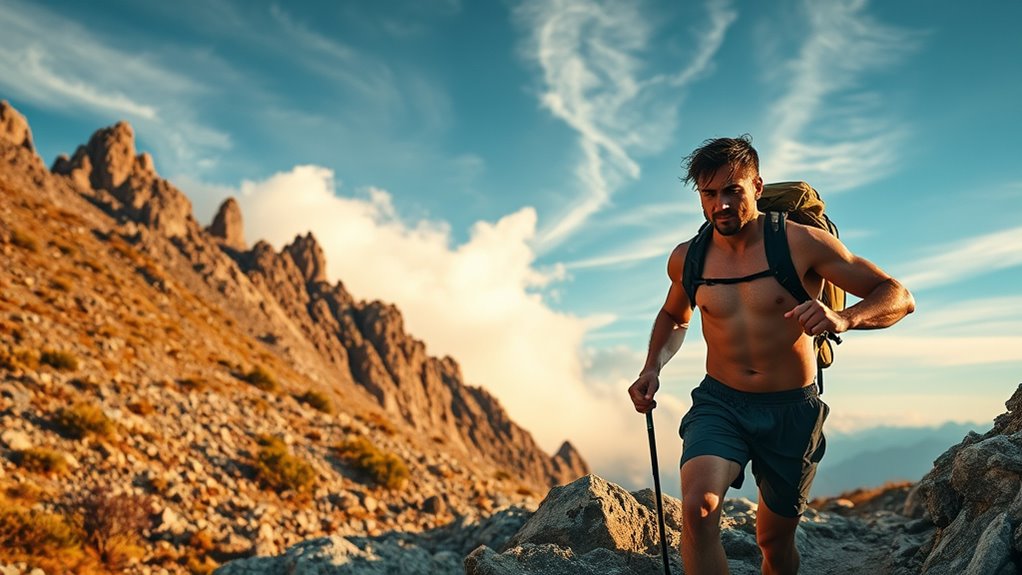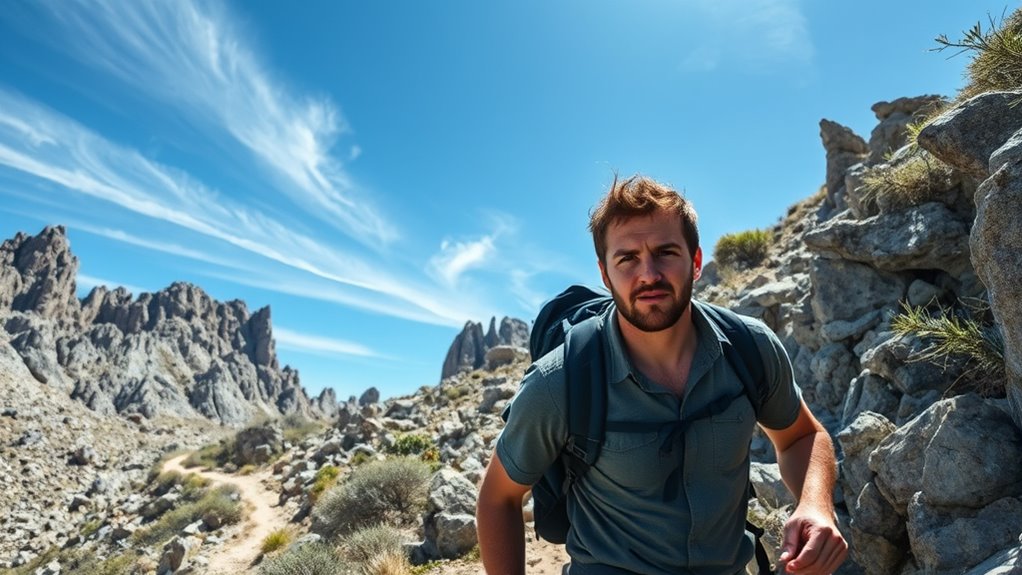When you undergo altitude and heat acclimation, your cardiovascular system works harder as it adjusts to oxygen and temperature changes. Your body produces more red blood cells and improves blood flow to manage the stress, while mental resilience helps you stay focused. To adapt safely, you need consistent exposure, proper hydration, and awareness of your physical signals. Continue exploring to discover effective strategies that make your adaptation smoother and more successful.
Key Takeaways
- Gradual ascent and exposure improve the body’s ability to adapt to altitude and heat stress.
- Increased red blood cell production enhances oxygen delivery at high elevations.
- Proper hydration and nutrition support cardiovascular health during acclimation.
- Psychological resilience and stress management aid in mental adaptation to demanding environments.
- Recognizing physical and mental symptoms helps prevent altitude sickness and heat exhaustion.

Adjusting to high altitudes and extreme heat requires your body to adapt quickly to challenging conditions. When you ascend to higher elevations, your cardiovascular system faces increased demands. Your heart must pump more blood to deliver oxygen efficiently, which can put extra strain on your cardiovascular health. Over time, your body responds by producing more red blood cells, boosting oxygen-carrying capacity. This adaptation helps you perform physical activities more effectively at altitude, but it also means your heart works harder initially, which could cause dizziness or shortness of breath. Similarly, in extreme heat, your cardiovascular system works overtime to cool your body through increased blood flow to the skin, leading to elevated heart rate and potential dehydration. Recognizing these effects allows you to pace yourself and stay hydrated, minimizing risks and supporting your overall health.
Alongside physical adjustments, psychological adaptation processes play a vital role in acclimation. When you’re in unfamiliar, demanding environments, your mental resilience is tested. You might experience frustration, anxiety, or fatigue, especially if symptoms like headaches or nausea occur. These psychological responses are natural, but they can also impact your body’s physical adaptation. Maintaining a positive mindset and focusing on gradual progress helps you stay motivated and reduces stress, which can otherwise hinder acclimation. Visualization techniques, deep breathing, and mindfulness can ease psychological strain, making it easier for your body to adapt more smoothly. The mental effort involved in acclimating shouldn’t be underestimated, as it influences your overall capacity to persevere through discomfort and continue with your activities. Additionally, understanding the sound design principles behind effective communication can support educational efforts on acclimation strategies.
The process of adaptation also involves learning how your body reacts under these conditions. You become more attuned to signals of overexertion or dehydration, adjusting your activity levels accordingly. This heightened awareness is part of the psychological adaptation process and helps prevent altitude sickness or heat exhaustion. As you acclimate, your body gets better at regulating temperature and oxygen levels, but this takes time. Consistent exposure, combined with proper hydration, nutrition, and rest, supports both your cardiovascular health and mental resilience. Ultimately, these interconnected adaptation processes enable you to perform better, stay healthier, and enjoy your experience despite the challenging environment. Understanding how your body responds and making deliberate adjustments can make all the difference in safely and effectively managing altitude and heat stress.
Frequently Asked Questions
How Long Does Heat Acclimation Typically Take?
Heat acclimation typically takes about 1 to 2 weeks, depending on your exercise duration and intensity. You should aim for daily sessions of 60 to 90 minutes, gradually increasing intensity. Hydration strategies are essential—drink plenty of fluids before, during, and after workouts. Consistent exposure helps your body adapt by improving sweating efficiency and cardiovascular performance, making you more comfortable and safer in hot conditions.
Can Altitude and Heat Acclimation Be Done Simultaneously?
Yes, you can do altitude and heat acclimation simultaneously through combined training, but it requires careful acclimation sequencing. You’ll want to gradually introduce both stresses, starting with lower altitudes or temperatures and increasing over time. While some adaptations may overlap, balancing the training load is key. This approach can boost your overall resilience, but listen to your body to prevent overtraining or fatigue.
What Are Signs of Over-Acclimation or Exhaustion?
You might notice signs of over-acclimation, like persistent fatigue, dizziness, or difficulty sleeping, which show your body’s struggling to adapt. Signs of exhaustion include muscle weakness, headache, nausea, and a decline in performance. If you experience these symptoms, it’s essential to rest, hydrate, and recover. Ignoring them can lead to more serious issues, so listen to your body and adjust your activity levels accordingly.
Are There Specific Diets That Aid Acclimation?
Sure, because nothing screams “perfect” like a diet tailored for your body’s adaptation needs. You should prioritize nutritional strategies rich in carbs, electrolytes, and antioxidants to support your body’s adjustment. Hydration optimization is key—drink plenty of water and replenish electrolytes with sports drinks or foods like bananas and spinach. Avoid processed foods, and listen to your body’s signals. This approach helps you acclimate faster and stay energized throughout your journey.
How Does Acclimation Differ for Elite Athletes Versus Amateurs?
You’ll find that elite athletes often follow specialized training protocols and focus on psychological adaptation to optimize acclimation, allowing quicker and more effective adjustments. They have access to advanced techniques and personalized plans, which amateurs might lack. As an amateur, you may need more gradual exposure and mental preparation to adapt successfully. Your training should prioritize consistency and patience, emphasizing both physical and psychological aspects of acclimation for better performance.
Conclusion
While some might think acclimation takes too long or isn’t worth the effort, it’s actually a game-changer for your performance and safety. By gradually adjusting to altitude or heat, you’ll boost your stamina, reduce fatigue, and prevent dangerous conditions. Don’t let fear of the process hold you back—you’ll notice the benefits faster than you expect. Embrace the challenge, stay consistent, and watch how your body adapts, giving you the edge you need for any adventure.









